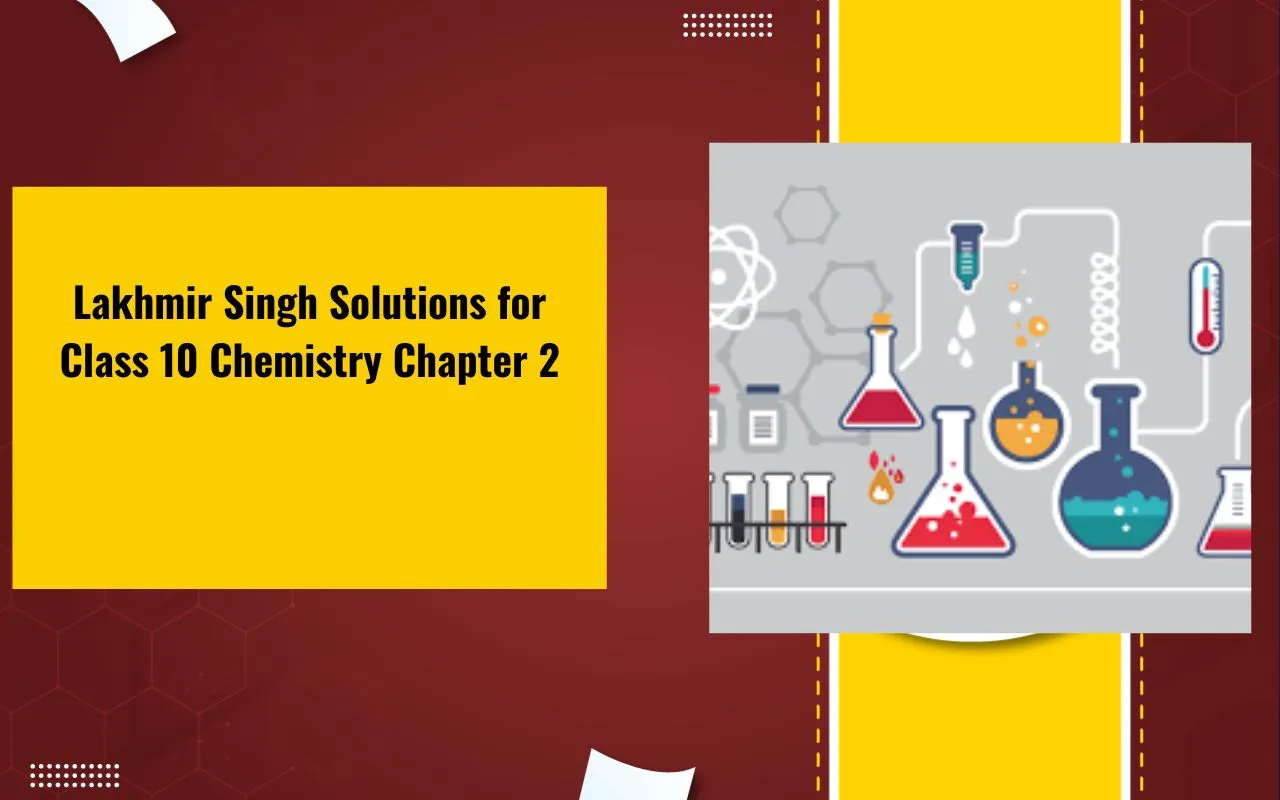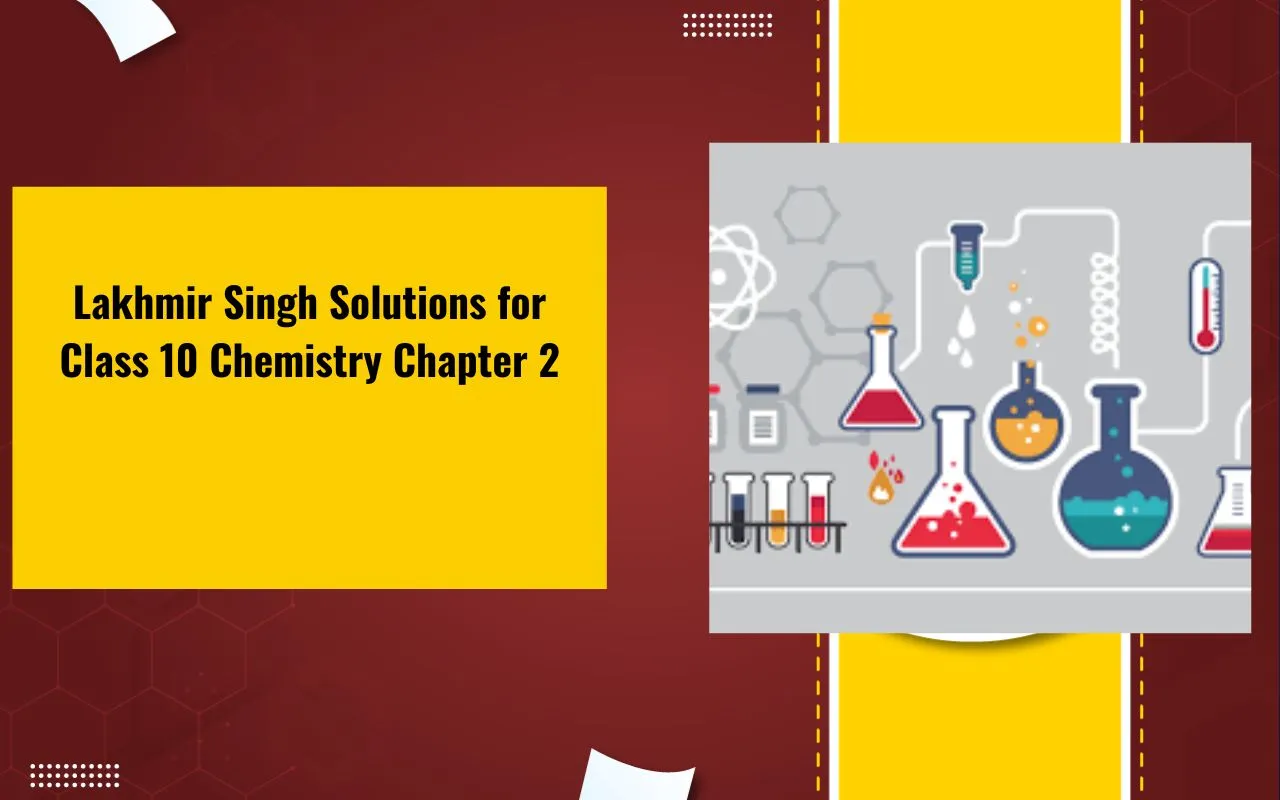

Lakhmir Singh Solutions for Class 10 Chemistry Chapter 2: Lakhmir Singh Solutions for Class 10 Chemistry Chapter 2 Acids, Bases, and Salts provide detailed answers and explanations for all the textbook exercises, helping students understand the properties, reactions, and uses of acids, bases, and salts.
This chapter covers essential topics such as the definitions of acids and bases according to Arrhenius, Bronsted-Lowry, and Lewis theories, the concept of pH scale, neutralization reactions, and the preparation of salts. With step-by-step explanations and well-structured solutions, students can easily grasp complex topics, enhance their problem-solving skills, and build a strong foundation for their board exams.
Lakhmir Singh Solutions for Class 10 Chemistry Chapter 2 Overview
Chapter 2 of Class 10 Chemistry Acids, Bases, and Salts focuses on understanding the nature, properties, and reactions of acids, bases, and salts. The chapter begins by explaining acids and bases based on various theories such as Arrhenius, Bronsted-Lowry, and Lewis concepts.
It also covers the physical and chemical properties of acids and bases, including their reactions with metals, metal oxides, and each other.
The concept of the pH scale is introduced to help students understand the strength of acids and bases and their significance in everyday life. Additionally, the chapter explains the process of neutralization reactions and the preparation of different types of salts, along with their properties and uses.
The Lakhmir Singh Solutions provide detailed explanations and step-by-step answers to all textbook questions, helping students effectively grasp concepts and improve their problem-solving skills.
Lakhmir Singh Solutions for Class 10 Chemistry Chapter 2 PDF
The Lakhmir Singh Solutions for Class 10 Chemistry Chapter 2 Acids, Bases, and Salts provide detailed explanations and answers to all textbook exercises, making it easier for students to understand concepts like acids, bases, salts, pH scale, and neutralization reactions.
These solutions are structured to help students strengthen their understanding and enhance their problem-solving skills. The PDF link is available below for easy access and download, ensuring a convenient study experience.
Lakhmir Singh Solutions for Class 10 Chemistry Chapter 2 PDF
Lakhmir Singh Solutions Class 10 Chemistry Chapter 2 Acids, Bases and Salts
Here are the Lakhmir Singh Solutions for Class 10 Chemistry Chapter 2 Acids, Bases, and Salts. With step-by-step solutions and simplified language, these resources help students strengthen their understanding and enhance their problem-solving skills effectively.
Very Short Answer Type Questions
1. What colour do the following indicators turn when added to a base or alkali (such as sodium hydroxide)?
(a) Methyl orange (b) litmus (c) red cabbage extract
Solution:
(a) When methyl orange is added to a base, it turns colour into yellow
(b) Litmus paper changes into blue when dipped in base solution. It changes colour from red to blue as the solution is an alkali
(c) Red cabbage extract turns into green colour when added to a base
2. What colours do the following indicators turn when added to an acid (such as hydrochloric acid)
(a) Litmus (b) methyl orange
Solution:
(a) Litmus paper is an indicator used to identify whether the solution is acidic or basic. Here when this is dipped in an acidic solution like hydrochloric acid, it turns blue colour to red.
(b) Methyl orange is also an indicator that shows colour change in different solutions. In acid solutions, it changes its colour to red.
3. Name an indicator which is red in the acid solution but turns blue in the basic solution.
Solution:
Litmus is used as an indicator to identify whether the solution is acidic or basic by changing its colour from solution to solution. In an acidic solution, the litmus colour changes from blue to red, and in alkali solutions, the colour changes from red to blue.
4. Name an indicator which is pink in an alkaline solution but turns colourless in an acidic solution.
Solution:
Phenolphthalein is used as an indicator in acid-base titrations, and it turns colourless in acidic solutions and turns into pink in basic solutions.
5. When a solution is added to a cloth strip treated with onion extract, then the smell of onion cannot be detected. State whether the given solution contains an acid or base.
Solution:
The given solution contains base because onion extract loses its smell when added to a base, but its smell does not change when added to acid.
6. When a solution is added to vanilla extract, then the characteristic smell of vanilla cannot be detected. State whether the given solution is an acid or a base.
Solution:
The given solution will be base because when a basic solution is added to vanilla, it completely destroys the characteristic smell of vanilla and when in an acidic solution, it does not change
7. How will you test for the gas which is liberated when hydrochloric acid reacts with an active metal?
Solution:
When hydrochloric acid reacts with active metal hydrogen gas will be evolved at the surface of the metal in the form of bubbles and thus formed gas is passed through soap and bring a candle near the bubble formed. If the gas burns with a pop sound then it can be concluded that it is hydrogen.
8. Name the gas that evolved when dilute HCl reacts with sodium hydrogen carbonate. How is it recognized?
Solution:
Carbon dioxide gas is liberated when hydrochloric acid reacts with sodium hydrogen carbonate. The gas liberated thus will pass through lime water, and lime water turns milky due to the presence of carbon dioxide, further, if we do the same, the solution becomes clear.
9. Give the formulae of two strong acids and two weak acids.
Solutio:
Strong acids are those which dissociate into ions in water. Eg: Hydrochloric acid (HCl) and Sulphuric acid (H2SO4)
Acetic acid (CH3COOH) and Citric acid (C6H8O7) are weak acids which are partially dissociated into their ions in water
10. Name on natural source of each of the following acids:
(a) Citric acid (b) Oxalic acid
(c) Lactic acid (d) Tartaric acid
Solution:
(a) The natural source of citric acid is from Lemon
(b) The natural source of oxalic acid is from tomatoes
(c) The natural source of Lactic acid is from sour milk or curd.
(d) The natural source of Tartaric acid is from tamarind
11. Name one animal and one plant whose stings contain formic acid (or methanoic acid)
Solution:
Animal sting containing Formic acid: Ants
Plant sting containing Formic acid: Nettle leaf sting
12. How is the concentration of hydronium ions (H3O+) affected when the solution of an acid is dilute?
Solution:
The concentration of hydronium ion decreases on diluting an acid. Thus the strength of the acid decreases.
Concentration of hydronium ions = Volume of solute (acid)/Volume of solution
13. Write word equations and then balanced equations for the reactions taking place when :
(a) dilute sulphuric acid reacts with zinc granules.
(b) dilute hydrochloric acid reacts with magnesium ribbon.
(c) dilute sulphuric acid reacts with ammonium powder.
(d) dilute hydrochloric acid reacts with iron filings.
Solution:
(a) Sulphuric acid + Zinc → Zinc Sulphate solution + Hydrogen gas
H2SO4(aq) + Zn(s) → ZnSO4 (aq) + H2(g)
(b) Hydrochloric acid + Magnesium → Magnesium chloride solution + Hydrogen gas
2HCl(aq) + Mg(s) → MgCl2(aq) + H2(g)
(c) Sulphuric acid + Aluminium → Aluminium sulphate solution + Hydrogen gas
3H2SO4(aq) + 2Al(s) → Al2(SO4)3(aq) + H2(g)
(d) Hydrochloric acid + Iron → Iron(III) Chloride solution + Hydrogen gas
6HCl(aq) + 2Fe(s) → 2FeCl3(aq) + 3H2(g)
Page no: 67
14. Complete and balance the following chemical equations:
(a) Zn(s) + HCl(aq) →
(b) Na2CO3(s) + HCl (aq) →
(c) NaHCO3(s) + 6 HCl →
(d) NaOH(aq) + HCl(aq) →
(e) CuO(s) + HCl (aq) →
Solutio:
(a) Zn(s) + 2HCl(aq) → ZnCl2 + H2
(b) Na2CO3(s) + HCl (aq) → 2NaCl(aq) + CO2 (g) + H2O(l)
(c) NaHCO3(s) + 6 HCl → NaCl(aq) + CO2(g) + H2O(l)
(d) NaOH(aq) + HCl(aq) →NaCl(aq) + H2O(l)
(e) CuO(s) + HCl (aq) → CuCl2(aq) + H2O(l)
15. Fill in the blanks in the following sentences :
(a) Acids have a _______ taste and they turn _______ litmus to _______.
(b) Substances do not show their acidic properties without _______.
(c) Acids produce _______ ions on dissolving in water.
(d) Those substances whose smell (or odour) changes in acidic or basic solutions are called _______ indicators.
(e) Onion and vanilla extract are _______ indicators.
Solution:
(a) Sour; blue; bed.
(b) Water.
(c) Hydrogen.
(d) Olfactory.
(e) Olfactory.
Short Answer Type Questions
16. (a) What is an indicator? Name three common indicators.
(b) Name the acid-base indicator extracted from lichen.
(c) What colour does the turmeric paper turn when put in an alkaline solution?
Solution:
(a) An indicator is a dye that shows a distinct change in colour when put in acid or base or as the ion concentration changes. Litmus, Methyl orange and phenolphthalein are the examples for indicators.
(b) Litmus is the acid-base indicator extracted from lichen. It will show colour change blue to red when in acid and red to blue in base
(c) When turmeric paper is dipped in an alkaline solution it will turn to red.
17. What is an olfactory indicator? Name two olfactory indicators. What is the effect of adding sodium hydroxide solution to these olfactory indicators?
Solution:
Olfactory indicators are those smell or odour changes when it is mixed in an acidic or basic solution. It can be used in laboratory to test whether the solution is base or acid and can perform olfactory titration
Onion and vanilla extracts are the olfactory indicators
When a basic solution like sodium hydroxide solution is added to a cloth strip treated with onions, the smell cannot be detected
18. (a)What happens when an acid reacts with a metal? Give chemical equation of the reaction involved.
(b) Which gas is usually liberated when an acid reacts with a metal? How will you test for the presence of this gas?
Solution:
(a) When an acid reacts with a metal, then a salt and hydrogen gas are formed.
Zn(s) + 2HCl(aq) → ZnCl2 + H2
(b) Hydrogen gas is liberated when acid reacts with metal. It is observed that a formation of gas bubbles along the surface of the metal. The obtained bubbles is then passed through a soap solution and when a burning candle is brought near to the bubble, the gas present in the soap bubble will burn with a pop sound and hence it can be concluded that it is hydrogen because only hydrogen gas can make a pop sounds when it burns
19. While diluting an acid, why is it recommended that the acid should be added to water and not water to the acid?
Solutio:
While diluting an acid, it should always be done in a slow manner with a constant stirring and in small amount. The dilution of an acid is an exothermic reaction. When we add acid to water the heat that evolved gets absorbed by the water but if doing reverse, which is water added to acid a large amount of heat evolved and chances of acid splashing to the person handling will be more.
20. What happens when an acid reacts with a metal hydrogen carbonate? Write equation of the reaction which takes place.
Solution:
When an acid is added to metal hydrogen carbonate, carbon dioxide gas is liberated with a metal salt and water.
Eg: When sodium hydrogen carbonate reacts with hydrochloric acid, sodium chloride and water is formed with an evolution of carbon dioxide gas
Na2CO3(s) + HCl (aq) → 2NaCl(aq) + CO2 (g) + H2O(l)
21. (a)What happens when dilute hydrochloric acid is added to sodium carbonate? Write balanced equation of the reaction involved.
(b)Which gas is liberated when dilute hydrochloric acid reacts with sodium carbonate? How will you test for the presence of this gas?
Solution:
a) When dilute hydrochloric acid reacts with sodium carbonate, then sodium chloride, carbon dioxide and water are formed.
NaHCO3(s) + 2 HCl → 2NaCl(aq) + CO2(g) + H2O(l)
(b) Carbon dioxide gas is liberated during the reaction
The gas evolved when the acid reacts with sodium carbonate is passed through lime water, lime water turns milky or white precipitate of calcium carbonate is formed. This confirms the presence of carbon dioxide.
22. What happens when an acid reacts with a base? Explain by taking the example of hydrochloric acid and sodium hydroxide. Give equation of the chemical equation which takes place. What is the chemical name of such a reaction?
Solution:
When an acid reacts with base, then a salt and water is formed. When hydrochloric acid reacts with sodium hydroxide solution, then a neutralisation reaction takes place to form sodium chloride and water.
NaOH(aq) + HCl(aq) →NaCl(aq) + H2O(l)
Such reaction is called Neutralisation reaction.
23. What happens when an acid reacts with a metal oxide? Explain with the help of an example. Write a balanced equation for the reaction involved.
Solution:
When an acid reacts with metal oxide, A salt and water are obtained.
The reaction can be written as follows,
Acid+ Metal oxide → Salt + water
An eg: when a small amount of copper oxide is added to sulphuric acid, colour of the solution becomes blue and the copper oxide dissolves. The blue colour of the solution indicates the formation of copper(II) sulphate
CuO(s) + H2SO4 → CuSO4(aq) + H2O(l)
24. (a) What are organic acids and mineral acids?
(b) Give two examples each of organic acids and mineral acids.
(c) State some of the uses of mineral acids in industry.
Solution:
(a) Organic acids are the acids found naturally in plants and animals. They are weak acids and do not dissociate completely in water.
Mineral acids are those acids which are man-made and derived from one or more inorganic compounds. They are also known as inorganic acids.
(b) Organic acids: Lactic acid, citric acid
Mineral acids : Hydrochloric acid, Nitric acid
(c) Mineral acids are used for the synthesis of various chemicals
Dilute hydrochloric acids are used to remove the deposits inside boilers and to prevent corrosion of the boilers by the acids
Used in the processing of leather, purification of common salt etc.
Nitric acid is used as explosives and fertilizers.
25. What is meant by strong acids and weak acids? Classify the following into strong acids and weak acids :
HCl, CH3COOH, H2SO4, HNO3, H2CO3, H2SO3
Solution:
A strong acid is one that completely ionises in water to form a large amount of hydrogen ion
A weak acid is that one which partially dissociates in aqueous and produces small amount of hydrogen ions.
HCl, H2SO4, HNO3 are strong acids
CH3COOH, H2CO3, H2SO3 are weak acids
26. Why do HCl, H2SO4, HNO3 , etc., show acidic character in aqueous solutions while solutions of compounds like C6H12O6 (glucose) and C2H5OH (alcohol) do not show acidic character?
Solution:
HCl, H2SO4, HNO3 are those which dissociate in aqueous solutions to give H+ ions which determines the acidic property of acids.
Glucose and alcohol does not dissociate in aqueous solution even though they contains hydrogen atoms.
This is the reason HCl, H2SO4, HNO3 shows acidic character and glucose and alcohol do not shows acidic character
27. What is a neutralisation reaction? Explain with an example. Give the chemical equation of the reaction which takes place.
Solution:
Neutralisation reaction is the reaction between an acid and a base which results in the formation of salt and water.
When sodium hydroxide and hydrochloric reacts each other, sodium chloride and water is formed.
NaOH(aq) + HCl(aq) →NaCl(aq) + H2O(l)
28. Why should curd and other sour food stuffs (like lemon, juice, etc.) not be kept in metal containers (such as copper and brass vessels)?
Solution:
Curds and other sour foods stuffs are acidic in nature. Acids react with metal to produce hydrogen gas thus, it spoils the food and also forms some toxic metal compounds which make the foodstuffs to become poisonous
29. (a) What is produced if an acid is added to a base?
(b) Why does dry HCl gas not change the colour of dry litmus paper?
(c) What colour does phenolphthalein indicator turn when added to an alkali (such as sodium hydroxide)?
Solution:
(a) Salt and water is formed when acid is added to base
NaOH(aq) + HCl(aq) →NaCl(aq) + H2O(l)
(b) Because dry HCl does not undergo dissociation to form ions because of the absence of aqueous medium. Colour of the litmus paper changes when ions are present. Hence it does not change the colour of litmus paper
(c) Phenolphthalein indicator turns pink when added to an alkali like sodium hydroxide.
30. (a)Why do acids not show acidic behaviour in the absence of water?
(b)Why does an aqueous solution of an acid conduct electricity?
(c)Why does distilled water not conduct electricity whereas rain water does?
Solution:
(a)Mainly, the acid behaviour of an acid is due to the presence of hydrogen ions when acids are dissolved in water. It does not show acidic character in the absence of water because the dissociation of hydrogen ions from an acid occurs in the presence of water only.
(b) The aqueous solution of an acid conducts electricity due to the presence of charged particles. The charged particles are ions here. Hydrogen and hydronium ions. They carry electric currents thus acids conducts electricity
(c) Distilled water does not conduct electricity because distilled water is the purest water which is free from all the ionic species. But rainwater is not the pure form thus it contains impurities and therefore conducts electricity.
Benefits of Solving Lakhmir Singh Solutions for Class 10 Chemistry Chapter 2
Conceptual Clarity:
-
Clear understanding of Acids, Bases, and Salts, pH scale, reactions, and salt preparation.
-
Thorough grasp of fundamental concepts for easy understanding of complex problems.
Comprehensive Coverage of Topics:
-
Detailed explanations for every sub-topic.
-
Simplified answers with step-by-step guidance.
-
Practical examples and additional information for enhanced learning.
Simplified Language for Better Understanding:
-
Complicated terms and reactions explained in easy-to-understand language.
-
Accurate presentation of diagrams and chemical equations.
-
Step-by-step breakdown of problems for clarity.
Enhances Problem-Solving Skills:
-
Variety of problems from easy to difficult levels.
-
Boosts analytical and reasoning skills.
-
Improves confidence in tackling tricky questions.
Strengthens Exam Preparation:
-
Follows the latest CBSE 10th syllabus and class 10 exam pattern.
-
Familiarizes students with commonly asked questions.
-
Ensures thorough revision and improves speed and accuracy.
Provides Reliable Reference Material:
-
Trusted guide for doubt-solving and cross-checking answers.
-
Accurate explanations and the correct approach to solving problems.
-
Useful for both self-study and guided learning.
Boosts Confidence Level:
-
Regular practice enhances preparedness for exams.
-
Minimizes errors through continuous practice.
-
Builds confidence in understanding difficult concepts
Lakhmir Singh Solutions for Class 10 Chemistry Chapter 2 FAQs
What topics are covered in Lakhmir Singh Solutions for Class 10 Chemistry Chapter 2?
Why are Lakhmir Singh Solutions useful for Chapter 2?
How do these solutions help in understanding acids and bases?
Are these solutions helpful for board exam preparation?













